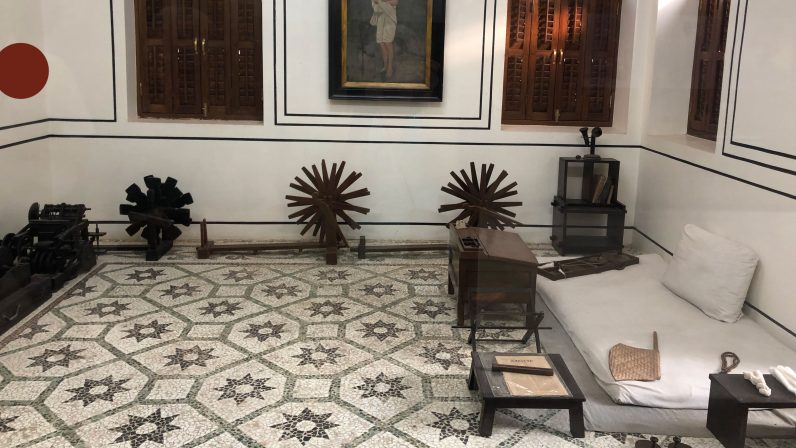To be fully transparent, I’ve had trouble focusing on my work this week. It’s not that I haven’t tried, my mind is merely elsewhere. I made a list of upcoming projects to inspire concentration, and still my attention wanders to faraway beaches on the Arabian Sea, and brightly colored clothing of the Indian people. Glancing at the photo of Mahatma Gandhi that’s been on my desk for years, I remember the last place we visited in Mumbai before heading home. Although it had been on our list of places to see, the Gandhi museum kept being replaced by other interests. Then, right before closing time, hours before we would check in for our flight, we stepped into the house where Gandhi lived from 1917 to 1934, whenever he was in Mumbai.
The house, now a museum, contained a library of books Gandhi had read, along with others related to his work. The walls were covered with beautiful photos of his life among dignitaries, family members, and young children, and some had quotes accompanying them. Upstairs there were a few rooms that contained a series of dioramas depicting the events of Gandhi’s life. Details of the 3-D figures were phenomenal and visually informative in bringing to life moments that changed India, and the world through his practice of satyagraha, passive political resistance.
Just when I thought our tour was finished, we approached a glass enclosed room. As the late afternoon sun shone through the door onto the white tile floor, it dawned on me what the space in front of me was. The room, with its profound simplicity, served as Gandhi’s office during the years he lived there. I could envision him sitting on the white floor cushion with people like Nehru, discussing next steps of the movement. Near the cushion were various spinning wheels. The spinning wheel became the unifying element of the nationalist movement in India, and Gandhi promoted the important of spinning thread for a variety of reasons, not unlike a spiritual practice.
Being able to see his space and feel its energy felt like a sacred opportunity. It renewed my interest in his practices of nonviolent resistance, and it seemed like an auspicious way to end our trip. It also gave me something to carry with me as I returned home and back to my work at the Seed. Gandhi’s standing up to the British empire was a profound example of standing up for one’s beliefs. I know I will draw inspiration from his life as I continue the work ahead. I leave you with a few Gandhi quotes displayed at the museum:
“Ahimsa (noninjury/nonviolence) is the highest ideal.”
“To call women the weaker sex is a libel; it is man’s injustice to woman…If your strength is meant moral power then woman is immeasurably man’s superior…If non-violence is the law of our being the future is with women.”
“Experience has taught me that silence is a part of the spiritual discipline of a votary of truth. Proneness to exaggerate, to suppress or modify the truth, wittingly or unwittingly, is a natural weakness of man, and silence is necessary in order to surmount it. A man of few words will rarely be thoughtless in his speech; he will measure every word.”

